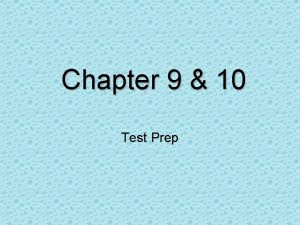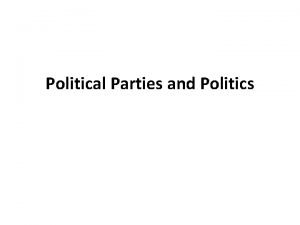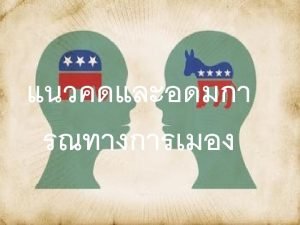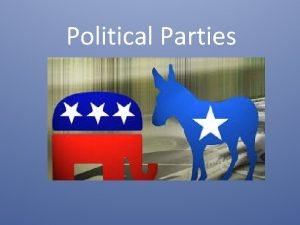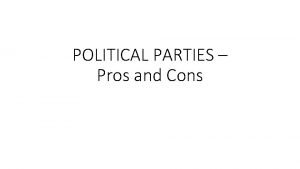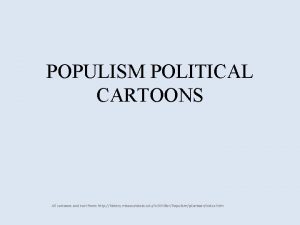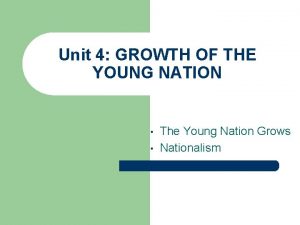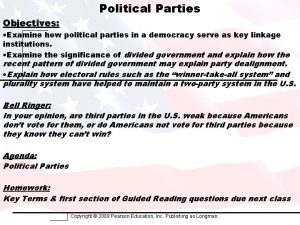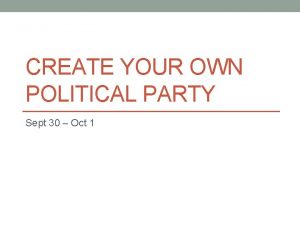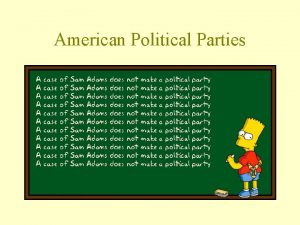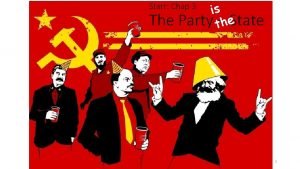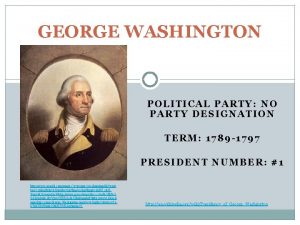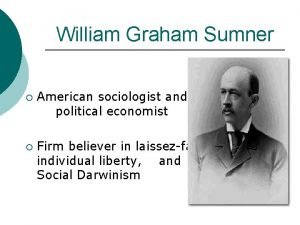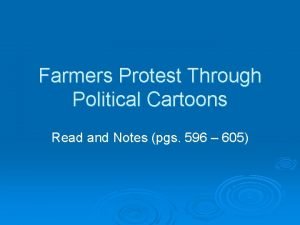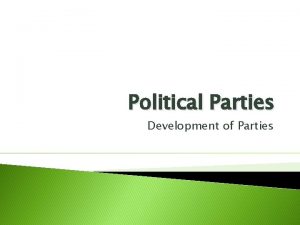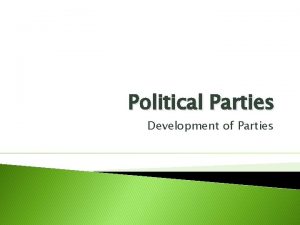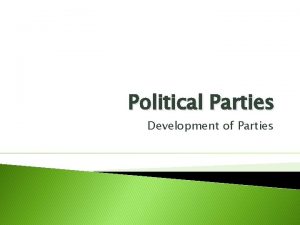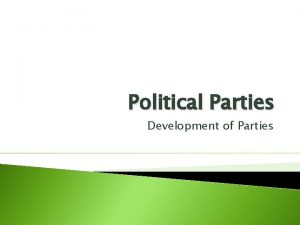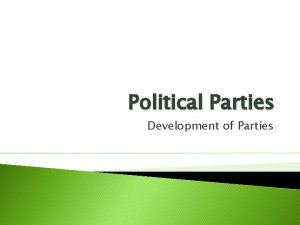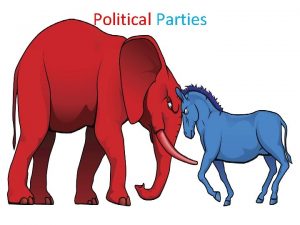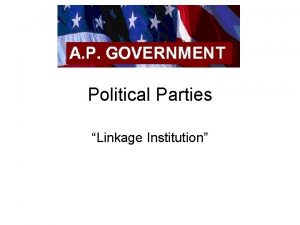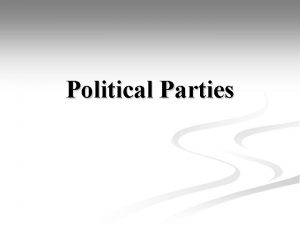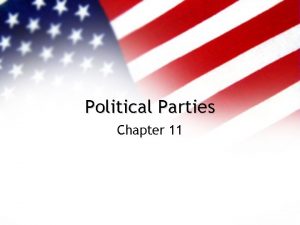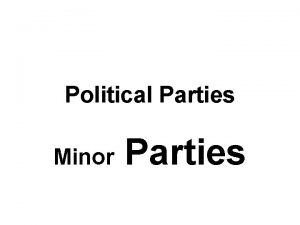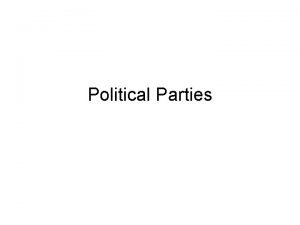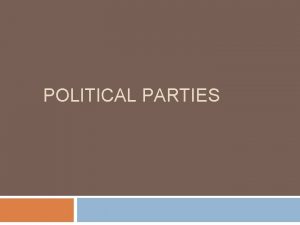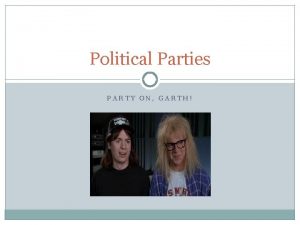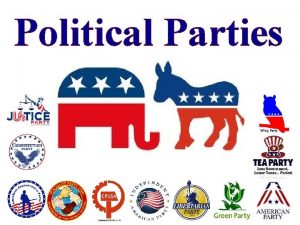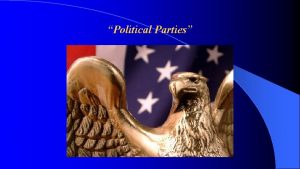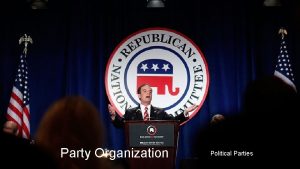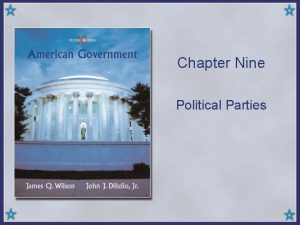Political Parties Development of Parties Political party Group




















- Slides: 20

Political Parties Development of Parties

Political party � Group of people with broad common interests who organize to win elections, control government, and thereby influence government policies.

Political party tasks � Pick candidates � Run campaigns � Give cues to voters � Articulate policies � Coordinate policymaking

One-Party System � The party is the government and the party leaders set government policy � Usually found in nations with authoritarian governments. ◦ One-party Communist governments �Cuba, Vietnam, North Korea, China ◦ One-party Theocracy (government run by religious officials) �Iran ◦ One-party authoritarian system �Russia

Multiparty System � Most common political system today ◦ France, Italy � Parties often represent widely differing ideologies (basic beliefs about government) � Voters have a wide range of choices on election day � One party rarely gets enough support to control the gov’t so several parties often combine forces to obtain a majority and form a coalition government (groups w/diff. ideologies share power ◦ Break down when disputes arise � Tend to be politically unstable

Two-Party Systems � Two major parties compete for power, although minor parties exist � Only about 2 dozen nations in world � United States ◦ Democratic and Republican Party

Role of minor parties/third parties � Any party other than one of the two major parties � Labeled “third” parties because they rarely win major elections � Believe that neither major party is meeting certain needs- run candidates who propose ways to remedy situation.

Three types of Third Parties � Single-issue party focuses exclusively on one major social, economic, or moral issue; generally short lived ◦ Liberty Party; Free Soil Party � Ideological party has a particular set of ideas about how to change society overall ◦ Socialist Labor Party; Communist Party � Splinter party splits away from one of the major parties because of some disagreement ◦ Progressive Party; Bull Moose Party

Impact of Third Parties � Can influence the outcome of national elections � Promote new ideas that are adopted by major parties ◦ Min. wage; five day workweek; unemployment and health insurance

Obstacles to Third Parties � Single-member districts- system where no matter how many candidates compete in a district, only one will win. ◦ Because most voters support a major party, the winner has almost always been a Democrat or a Republican � Many nations use an election system based on proportional representation- several officials are elected to represent voters in an area. ◦ Offices are filled in proportion to the votes that each party’s candidates receive. ◦ Encourages minority parties

Political Parties Organization

Organization � All generally cooperate, but are independent of each other ◦ Local ◦ State ◦ National

Local Party Organization � Precinct: basic, local, voting district where voters cast their ballots at the same polling place � Precinct captain: organizes party workers to distribute info. about party and its candidates and to attract voters to the polls � Ward: several adjoining precincts comprise a larger district � Each precinct chooses a chairperson to represent ward at the party’s county committee � County committee selects a chairperson to handle the county party’s daily affairs

State Party Organization � State central committee: comprised largely of reps from the party’s county organizations � Chooses party state chairperson � Helps elect the party’s candidates for state government offices � Provides assistance to local parties and candidates � Helps coordinate the activities of local parties � Raises money

National Party Organization � National convention: a gathering of party members and local and state party officials that meets every four years primarily to nominate the party’s presidential and vice-presidential candidates � National committee: large group comprised mainly of reps from the 50 state party organizations runs the party � Elects party chairperson who manages daily operations- usually the choice of the party’s pres. candidate ◦ Raises money for party ◦ Touts achievements ◦ Promotes national, state, and local party cooperation

Membership � Provides ways for citizens to influence government, esp. at the local level � Most citizens declare membership when they register to vote ◦ May choose Independent if you do not support any particular party � No duties or obligations beyond voting � Must be a member to hold office or be its candidate � Ways to support party ◦ Contributing money ◦ Volunteer work for party or candidates

Political Parties Nominating Candidates

Primary � Meetings of party members who choose almost all candidates for office ◦ Direct primary= elections in which party members select people to run in the general election ◦ Closed primary= only members of a political party can vote ◦ Open primary= all voters may participate, even if they do not belong to the party, but they can vote in only one party’s primary � Candidate requires a plurality: more votes than any other candidate

Petition �A person announces his/her candidacy and files petitions that a specified number of voters have signed in order to be placed on the ballot � In a primary contest, the party-backed candidate has an advantage b/c party workers will circulate petitions and use its financial and organizational resources to back its candidate

Presidential Nominations � Presidential Primaries ◦ May use a delegate selection process or a presidential preference poll, or both ◦ Winner-take-all or proportional delegates system � National Convention officially nominates presidential and vice presidential candidate and adopts a party platform ◦ Sometimes planks divide the party
 Third party and fourth party logistics
Third party and fourth party logistics Brainpop voting
Brainpop voting The spoils system made political parties more powerful by
The spoils system made political parties more powerful by Political parties
Political parties Political parties
Political parties Political party
Political party Soup and ideology
Soup and ideology Political parties
Political parties Political parties pros and cons
Political parties pros and cons Populism political cartoons
Populism political cartoons Main idea
Main idea Objectives of political party
Objectives of political party Create a political party project
Create a political party project Kathy cocuzzi political party
Kathy cocuzzi political party Political party
Political party Political party
Political party Political party project
Political party project Political party organization chart
Political party organization chart George washington political party
George washington political party Graham sumner roman
Graham sumner roman Analyzing the populist party through political cartoons
Analyzing the populist party through political cartoons


